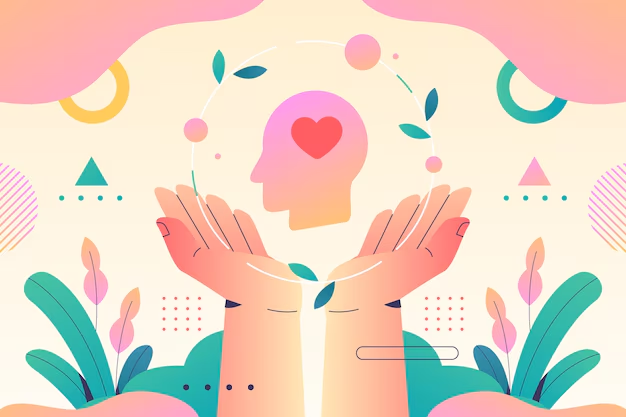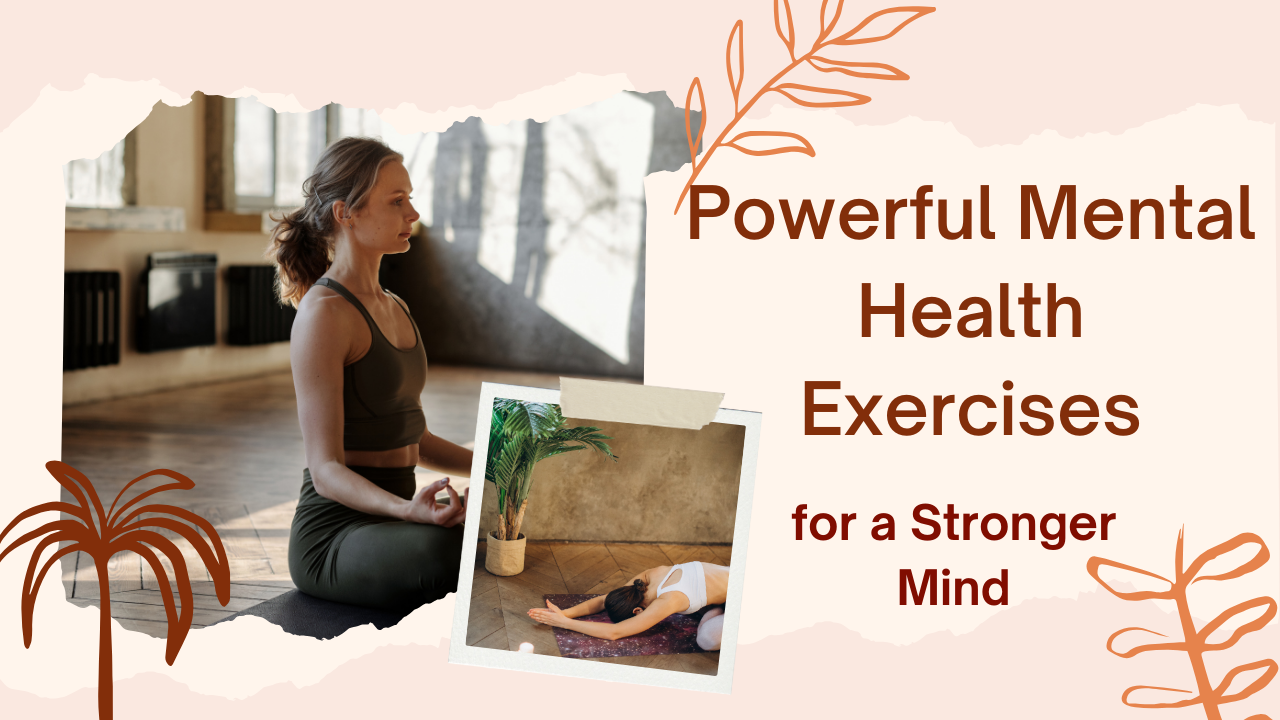Mental health is no longer a taboo topic; it’s now an integral part of the wellness conversation. While therapy and medication play essential roles for many, mental health exercises are an often-overlooked yet powerful complement to treatment. These exercises focus on strengthening the mind, much like physical workouts strengthen the body.
Just as we build muscles through exercise, mental health exercises foster resilience, emotional intelligence, and well-being. These practices are supported by psychology, neuroscience, and mindfulness, making them effective tools for managing stress and anxiety.
Engaging in regular mental health exercises can significantly improve emotional balance and help individuals combat depression. They offer practical methods for building mental strength, which contributes to a healthier, more fulfilling life.
Understanding Mental Health and the Importance of Exercise

What Is Mental Health ?
Mental health involves our emotional, psychological, and social well-being, shaping how we think, feel, and act. It affects our ability to handle stress, relate to others, and make decisions. Maintaining good mental health is essential for leading a balanced and fulfilling life, influencing overall well-being and our interactions with the world around us.
Good mental health helps us:
Cope with the stresses of life
Work productively
Build strong relationships
Make sound decisions
Recover from setbacks
Neglecting mental health can lead to anxiety, depression, chronic stress, and emotional burnout. These conditions can significantly impact daily life, making it harder to manage emotions, maintain relationships, and perform everyday tasks. Prioritizing mental health is crucial for overall well-being and resilience in facing life’s challenges.
Why Mental Health Exercises Matter
While therapy provides structured support and medication helps correct chemical imbalances, exercises empower individuals daily.
Mental health exercises:
Encourage self-awareness
Reduce stress and anxiety
Enhance focus and clarity
Build coping skills
Improve mood and emotional regulation
These practices are proactive—not just reactive.
Mindfulness and Meditation Exercises
Mindfulness and meditation are among the most well-researched and widely recommended mental health practices. These techniques help individuals stay present, reduce stress, and manage negative emotions by fostering awareness and acceptance of their thoughts and feelings. Regular practice of mindfulness and meditation has been shown to improve emotional regulation, decrease anxiety, and promote relaxation. By incorporating these practices into daily routines, individuals can build resilience, enhance self-awareness, and achieve a greater sense of mental clarity and balance, supporting overall well-being in both personal and professional life.

What Is Mindfulness ?
Mindfulness is the act of paying full attention to the present moment without judgment. It’s simple in theory but profound in practice.
Key Mindfulness Exercises:
a) Body Scan Meditation
Purpose: Reduces tension, improves body awareness
How: Lie or sit comfortably. Bring attention to your toes and slowly move up, noticing sensations in each body part.
b) 5-4-3-2-1 Grounding Exercise
Purpose: Eases anxiety, brings focus to the present
How: Identify 5 things you can see, 4 you can touch, 3 you can hear, 2 you can smell, and 1 you can taste.
c) Breath Awareness
Purpose: Improves calm and focus
How: Focus on the sensation of breathing. Inhale deeply for 4 counts, hold for 4, exhale for 4, and pause for 4 (Box Breathing).
Cognitive Behavioral Techniques
Cognitive Behavioral Therapy (CBT) is a highly effective, evidence-based psychological treatment widely considered a gold standard. It focuses on identifying and changing negative thought patterns and behaviors that contribute to emotional distress. Simplified CBT tools can easily be integrated into daily life, helping individuals manage stress, anxiety, and depression. By challenging unhelpful thoughts and replacing them with more balanced perspectives, these tools promote emotional well-being and better coping strategies. Regular practice of CBT techniques can lead to lasting improvements in mental health, boosting resilience and overall quality of life.
Effective CBT-Based Exercises:
a) Thought Records
Purpose: Identify and challenge negative thoughts
How: Write down the situation, the thought, your feelings, evidence for/against the thought, and a more balanced conclusion.
b) Behavioral Activation
Purpose: Fights depression through action
How: Identify enjoyable or meaningful activities. Schedule and commit to doing them—even when you don’t feel like it.
c) Cognitive Restructuring
Purpose: Reframes distorted thinking
How: Notice patterns like catastrophizing or overgeneralizing. Replace with realistic, compassionate alternatives.
Journaling Practices for Mental Clarity
Journaling isn’t limited to artists or teenagers; it’s a powerful tool for enhancing mental health. Writing regularly allows individuals to express thoughts and emotions, helping to process experiences and reduce stress. It can provide clarity, promote self-reflection, and foster emotional healing. Journaling also helps in identifying patterns in thoughts or behaviors, offering a valuable opportunity for personal growth. By incorporating this practice into daily life, individuals can improve emotional well-being, boost resilience, and gain greater self-awareness.

Types of Therapeutic Journaling
a) Gratitude Journaling
Purpose: Increases positive emotions and satisfaction
How: Write 3 things you’re grateful for daily. Reflect on why each matters to you.
b) Emotional Release Journaling
Purpose: Processes complex feelings
How: Set a timer for 15 minutes. Write freely about your emotions without editing or censoring.
c) Goal Setting and Reflection
Purpose: Builds motivation and direction
How: Outline short- and long-term goals. Reflect weekly on progress, challenges, and adjustments.
Movement-Based Exercises for the Mind
Exercise is typically viewed as a physical activity, but its mental health benefits are equally significant. Regular physical activity helps reduce stress, anxiety, and depression by releasing endorphins, the brain’s natural mood boosters. It also improves sleep, boosts self-esteem, and enhances cognitive function. Whether it’s a brisk walk or an intense workout, exercise can elevate mood, increase mental clarity, and provide a natural sense of well-being. Incorporating regular physical activity into daily life can greatly support overall mental health.
Effective Movement Practices
a) Yoga
Combines physical postures with breath and meditation
Improves flexibility, reduces cortisol, enhances mood
Try beginner poses like Child’s Pose, Downward Dog, or Sun Salutations
b) Walking Meditation
A mindful alternative to seated meditation
Walk slowly and notice each step, breath, and sound around you
c) Dance or Expressive Movement
Frees emotional tension and promotes joy
Use music you love—let your body move in any way it wants
Social and Connection Exercises
Human connection plays a crucial role in mental well-being. Positive relationships and social interactions provide emotional support, reduce feelings of loneliness, and promote a sense of belonging. Isolation, on the other hand, can lead to increased anxiety, depression, and a decline in overall mental health. Engaging with others, whether through family, friends, or community, helps foster emotional resilience and strengthens mental health. Building and maintaining meaningful connections is essential for sustaining a healthy, balanced mind.

Exercises to Foster Connection
a) Active Listening Practice
Purpose: Builds empathy and reduces conflict
How: In a conversation, fully listen. Reflect back what was said before offering your own view.
b) Connection Challenges
Purpose: Encourages outreach
How: Challenge yourself to reach out to a friend each day—even with a short text or call.
c) Acts of Kindness
Purpose: Boosts self-esteem and connection
How: Do something kind for someone without expecting anything in return
Visualization and Affirmation Techniques
Our brains react to imagined experiences nearly as intensely as they do to real ones. Whether we’re vividly visualizing a scenario or recalling past events, the brain processes these mental images and emotions in similar ways. This means that thoughts, memories, and daydreams can influence our mood, stress levels, and overall mental state. By consciously shaping our thoughts and focusing on positive or calming imagery, we can enhance emotional well-being and reduce stress, reinforcing the power of the mind in our mental health.
Guided Visualization
Purpose: Reduces stress, builds confidence
How: Imagine a safe, calming place in vivid detail. Engage all senses.
Positive Affirmations
Purpose: Rewrites limiting beliefs
How: Choose a statement that resonates (e.g., “I am capable and resilient”) and repeat it aloud daily.
Digital Detox and Screen Hygiene
Technology can overwhelm our minds with constant notifications and digital distractions. Reducing digital clutter is a valuable exercise in self-discipline, helping to restore mental clarity and focus. By limiting unnecessary screen time, organizing digital spaces, and setting boundaries for online interactions, we can reclaim our attention and reduce stress. This process promotes a healthier relationship with technology, allowing for improved productivity, better emotional balance, and a more present, mindful approach to daily life.

Effective Digital Practices
Tech-Free Mornings or Evenings
App Time Limits
Mindful Consumption: Ask, “Is this nourishing my mind or draining it?”
Sleep Hygiene and Restorative Practices
Mental health is closely linked to rest, as inadequate sleep significantly impacts emotional regulation and focus. Poor sleep can lead to irritability, heightened stress, and difficulty managing emotions. It also affects cognitive function, making it harder to concentrate, think clearly, and make decisions. Prioritizing quality sleep is essential for maintaining mental well-being, as it allows the brain to recharge, process emotions, and restore balance. Getting sufficient rest is a key factor in supporting emotional health and overall mental resilience.
Exercises for Better Sleep
Progressive Muscle Relaxation
Evening Journaling: Dump worries before bed
Consistent Sleep Routine: Go to bed/wake up at the same time daily
Combining Practices into a Routine
Consistency is crucial for mental well-being. Just as you would create a fitness plan for physical health, it’s important to establish a mental health workout routine. Incorporate daily practices like mindfulness, journaling, or deep breathing exercises, alongside regular emotional check-ins and stress management techniques. By making mental health a priority through consistent effort, you can build emotional resilience, improve coping skills, and enhance overall well-being. Treat your mental health regimen with the same commitment and structure as any physical fitness plan.
Sample Weekly Plan
| Day | Morning | Afternoon | Evening |
|---|---|---|---|
| Monday | Breathwork (5 mins) | Walk + Gratitude Note | Body Scan Meditation |
| Tuesday | Affirmations | Thought Record | Yoga (20 mins) |
| Wednesday | Journaling | Connection Challenge | Visualization |
| Thursday | Box Breathing | Behavioral Activation | Progressive Relaxation |
| Friday | Gratitude Journal | Dance Break | Guided Meditation |
| Weekend | Outdoor Walk | Tech Detox | Reflection Journaling |
When to Seek Professional Help
Mental health exercises are powerful but not a replacement for professional care when needed. Seek help if you experience:
Persistent sadness or anxiety
Loss of interest in daily life
Suicidal thoughts
Difficulty functioning at work or home
Therapists, counselors, and support groups are valuable allies.
Conclusion

Mental health exercises are not just trendy self-care; they are backed by science and serve as powerful tools to nurture both the mind and spirit. These exercises work to strengthen emotional resilience, enhance cognitive function, and improve overall mental well-being. Just as physical fitness requires regular activity to maintain strength, mental fitness needs consistent practice to stay balanced and healthy.
Engaging in daily mental health practices can significantly reduce stress, anxiety, and depression. Techniques like mindfulness, meditation, and cognitive exercises help reframe negative thought patterns, promote emotional regulation, and foster a positive mindset. These practices contribute to better mental clarity, improved focus, and a more peaceful state of mind.
Whether you’re struggling with anxiety, recovering from burnout, or seeking emotional balance, incorporating mental health exercises into your routine can create lasting positive change. By prioritizing mental fitness, you’ll experience a transformation in how you feel, think, and approach daily life.
FAQ 1: How often should I do mental health exercises ?
Answer: Ideally, mental health exercises should be practiced daily, just like physical workouts. Even 5–10 minutes a day can make a significant impact over time. Consistency matters more than duration—start small and gradually build a routine that fits your lifestyle.
FAQ 2: Can mental health exercises replace therapy or medication ?
Answer: No, mental health exercises are not a substitute for professional help when needed. They work best as a complement to therapy, medication, or other treatments. If you’re experiencing severe symptoms of depression, anxiety, or trauma, seek support from a licensed mental health professional.
FAQ 3: What if I don’t have time for long exercises every day ?
Answer: That’s okay! Even short practices—like a 2-minute breathing exercise, a quick gratitude note, or a mindful moment during a walk—can boost mental clarity and reduce stress. The key is being intentional, not perfect.
FAQ 4: Which exercise is best for managing anxiety ?
Answer: Breathwork (like box breathing), grounding exercises (like 5-4-3-2-1), and mindfulness meditation are especially effective for calming anxiety. They bring your attention back to the present and help regulate your nervous system.
FAQ 5: How do I stay motivated to keep practicing these exercises ?
Answer: Make your routine enjoyable and rewarding. Use habit trackers, set reminders, join a mental wellness group, or pair exercises with existing habits (like journaling after your morning coffee). Most importantly, remind yourself of how much better you feel after doing them.



